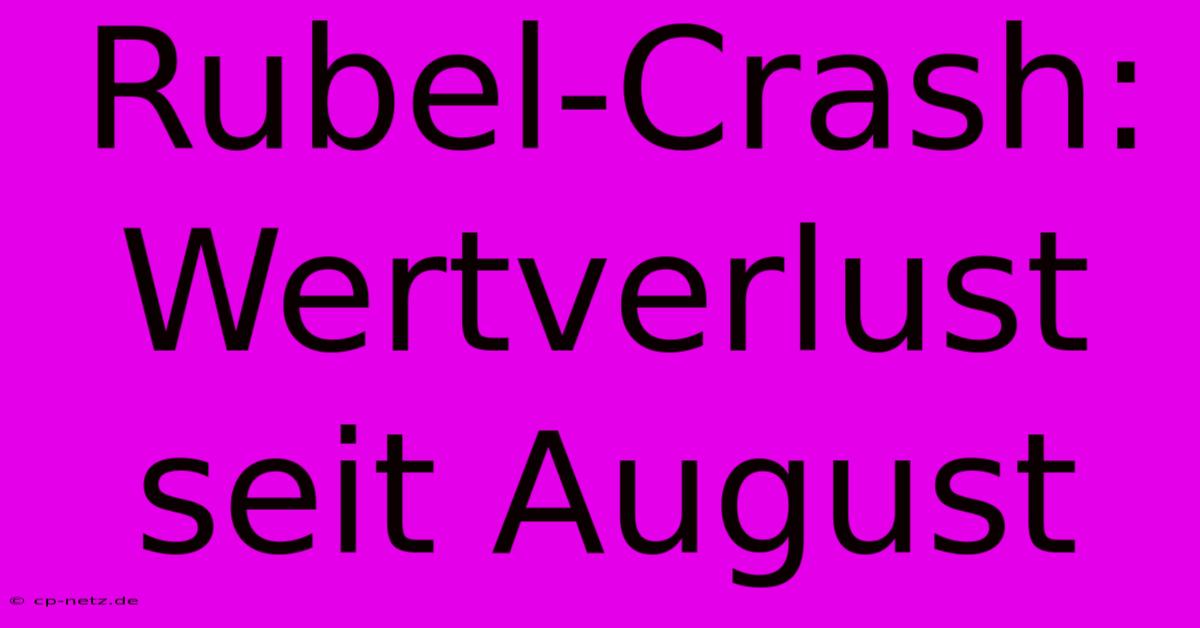Rubel-Crash: Wertverlust Seit August

Discover more detailed and exciting information on our website. Click the link below to start your adventure: Visit Best Website Rubel-Crash: Wertverlust Seit August. Don't miss out!
Table of Contents
Rubel-Crash: Wertverlust seit August – Meine Erfahrungen und Tipps
Hey Leute, let's talk about something that's been bugging me – the Rubel crash. Seriously, the value drop since August has been a wild ride, and I've learned a few things the hard way. I mean, who could've predicted this rollercoaster? Not me, that's for sure.
The Rollercoaster Begins: August and Beyond
Remember August? Things seemed, you know, normalish. Then, bam! The Rubel started its nosedive. I had some Rubel in a savings account – a small amount, thankfully, but still – watching it lose value felt like watching money disappear into thin air. It was super stressful, I’m not gonna lie.
I wasn't paying enough attention to economic news, that's my biggest regret. I was too busy with work and family and stuff. You know, life. Looking back, I should have been more informed about geopolitical risks and the impact on the Russian economy.
Lesson learned: Don’t bury your head in the sand. Stay updated on financial news and currency exchange rates. Even a little bit of knowledge can make a huge difference.
Diversification: My (Late) Epiphany
The Rubel crash really highlighted the importance of diversification. Putting all my eggs in one basket (or, in this case, one currency) was a huge mistake. I felt totally helpless watching my savings dwindle. Now I'm spreading my investments across different assets – stocks, bonds, maybe even some crypto (though that's another rollercoaster altogether!).
Understanding the Causes: Geopolitics and More
The Rubel's devaluation isn't just about one thing. It’s a complex situation influenced by various factors. International sanctions, global energy prices, and internal economic policies all play a role. To understand the situation better, I started reading articles from reputable sources like the Financial Times and Bloomberg. This wasn't easy reading, I’ll admit; it’s complicated stuff. But it helped me to better understand the macroeconomic factors influencing the Rubel's performance.
Practical Tips for Navigating Currency Volatility
Okay, so what can you do? Here's what I'm doing now:
- Regularly monitor exchange rates: This is crucial for anyone holding Rubel or planning transactions involving the currency. Check websites and apps regularly.
- Consider hedging strategies: If you have significant Rubel holdings, explore options like currency hedging to mitigate potential losses. Talk to a financial advisor if you’re not sure. This is really important if you have a large exposure to the Ruble.
- Don’t panic sell: Emotional reactions rarely lead to good financial decisions. It's important to create a long term strategy.
- Diversify your investments: Spread your assets across various currencies and asset classes. This reduces your risk.
- Stay informed: Keep yourself updated on relevant news and events.
Looking Ahead: What's Next for the Rubel?
Honestly, predicting the future of the Rubel is impossible. It’s uncertain. Experts have differing opinions; some are optimistic, others cautious. The situation is incredibly fluid, and the Rubel's value is likely to remain volatile for a while. But by understanding the factors at play and taking proactive steps, you can better manage your financial risk.
This whole experience has been a major learning curve for me. It’s taught me the importance of financial literacy and the need to stay informed. It sucks to lose money, but hopefully, my mistakes can help others avoid making the same ones. So, stay informed, folks! And let's hope for calmer waters ahead.
Keywords: Rubel-Crash, Wertverlust, August, Rubel, Russische Wirtschaft, Währungskurs, Geopolitik, Sanktionen, Investitionen, Diversifizierung, Finanznachrichten, Währungsrisiko, Hedging, Finanzplanung, wirtschaftliche Entwicklung

Thank you for visiting our website wich cover about Rubel-Crash: Wertverlust Seit August. We hope the information provided has been useful to you. Feel free to contact us if you have any questions or need further assistance. See you next time and dont miss to bookmark.
Featured Posts
-
Export Impulse Souss Massa
Nov 27, 2024
-
Grenze Nackt Kontrollen Stoppen Vf B Fans
Nov 27, 2024
-
S Bahn Berlin Feuer Vier Linien Aus
Nov 27, 2024
-
Finanzskandal Juan Carlos Im Visier
Nov 27, 2024
-
Dienstags Zoom Aktienkurs Gruende And Ausblick
Nov 27, 2024
